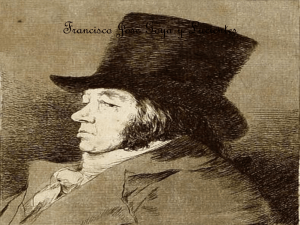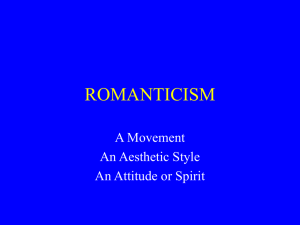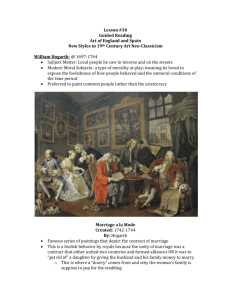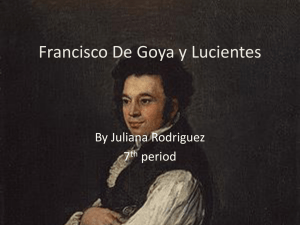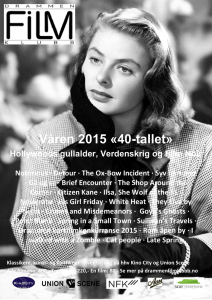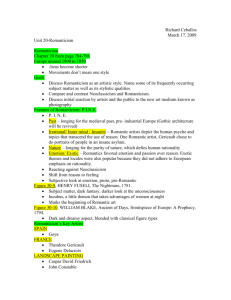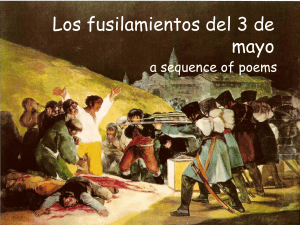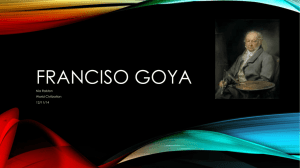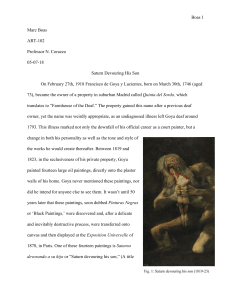Goya Power Point
advertisement
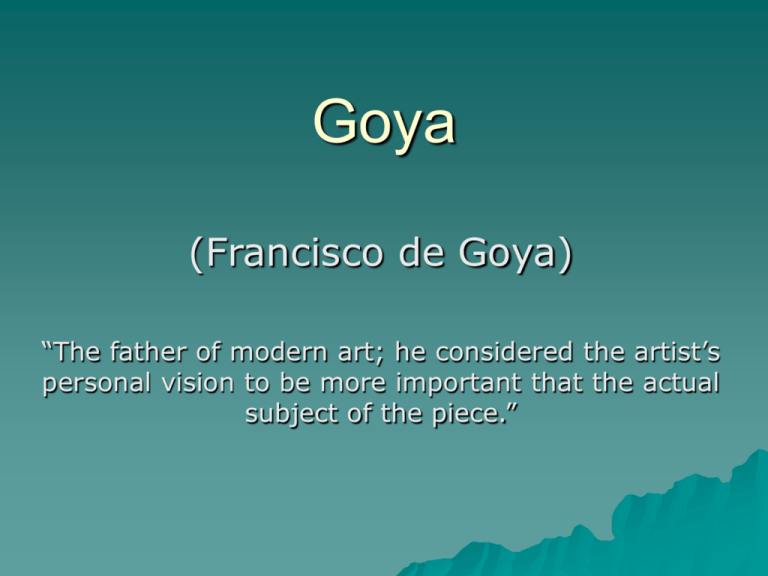
Goya (Francisco de Goya) “The father of modern art; he considered the artist’s personal vision to be more important that the actual subject of the piece.” His Life In 1746 he was born in Fuentetodos, Spain. He began to study under local painter Jose Luzan y Martinez at age 14. He studied in Rome for a year in 1771 then returned to Spain. He began his career as an artist of the court in 1775 when he worked for the Royal Tapestry Factory creating scenes of contemporary life & pastimes His Life—Con’t. In 1786 he was named painter to King Charles III. He became painter to King Charles IV in 1788 when he became the most successful and fashionable artist in Spain. He suffered from a horrible illness that left him deaf in 1792, which changed the way he painted. His Life—Con’t. He painted “Los Caprichos” in 1799; a series of 80 etchings that attacked political, social, & religious abuses of the time. These were caricatures, and he used a new technique that makes them a major achievement in the history of engraving. He was threatened by the Inquisition and forced to give these to the king. After Napoleon invaded Spain, he became his painter, and did a series of etchings called “The Disasters of War” that record the horror and brutality of war His Life—Con’t. He was later pardoned by King Ferdinand VII when he was restored as king in 1814. Tiring of the stupidity of the monarchy, he went to his country cottage with his maid and mistress, Leocadia Weiss and her daughter Rosario. There he painted the “Black Paintings” on the walls, not meant for public display In 1824 he was brought before the Inquisition and accepted exile in Bordeaux, France In 1828, he died in Bordeaux, France His Style He is known as the greatest interpreter of his age and of his country He has said that he has 3 masters: Rembrandt (etchings & engravings), Velazquez (study of nature & realism), and Nature itself He is famous for his vivid & accurate portrayal of historical events, and social critique He was the first to show the true horrors of war His Style-Con’t. He is called “The father of Modern Art” as he has influenced many 19th & 20th century artists “Imagination abandoned by reason produces impossible monsters; united with it, she is the mother of the arts and the origin and source of their wonders.” (Francisco de Goya) Goya Straw Mannequin (Dummy) (1792-2) 1. An example of a tapestry design made for the apartments of the Escorial palace 2. Shows a typical, lighthearted tradition during carnival. 3. A scene of contemporary life El Escorial Goya Witches’ Sabbath (1821-1823) 1. One of the black paintings, it shows a scene of despair, cynicism, and nightmare visions 2. Satan as a goat-man presides over a coven of ugly witches who offer up children as sacrifice 3. This is a condemnation of the popular superstition of the era surrounding the inquisition and witch trials 4. During this era, royalists used fear of accusation of witchcraft to control the lower class Goya—Saturn Devouring His Children 1. One of the black paintings 2. Portrays Roman myth of Saturn who is told that one of his sons will overthrow him as he did to his own father 3. To prevent this, Saturn eats each of his children as they are born 4. His wife, Ops, hides the 6th son, Jupiter, and fools Saturn by giving him a rock dressed in swaddling 5. Jupiter eventually overthrows his father and the prophecy is fulfilled 6. Many interpretations exist of this painting: -conflict between youth & old age -time devours all things -Goya’s relationship with his son, Xavier who is the only one of six to survive into adulthood Goya The Clothed (Naked) Maja (1800-1803) 1. The first “totally profane lifesize female nude in Western art” 2. The same woman in the same pose is in both 3. Her identity is not certain but some believe it is the Dutchess of Alba who may have been having an affair with Goya 4. It was owned, however, by a friend of Goya’s, Manuel de Godoy, and is probably his mistress. Godoy was exiled due to the inquisition at which time the painting was seized by Ferdinand VII. Goya—The Shootings of May 3rd 1808 (1814) 1. Commemorates the Spanish resistance to Napoleon’s army 2. A groundbreaking, archetypal image of the horrors of war 3. The victims have faces but the killers do not, thus showing war as anonymous killing 4. This painting ended the tradition of showing killing as noble and war as glorious Goya Extra notes The Milkmaid of Bordeaux (18251827) is believed to be a portrait of Leocadia or her daughter Rosario. The Black Paintings were transferred from the walls to canvas after his death. The portrait of “Family of Charles IV” -Goya is in the back, painting the picture -The family is not painted as beautiful but true to life -The girl in the back who is facing the wall is said to be the future wife of the prince and therefore was not yet known Francisco Goya Self Portrait w/ Dr. Arrieta
